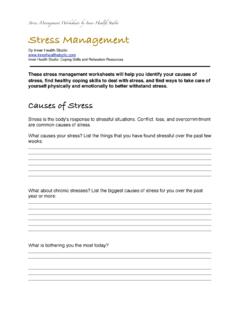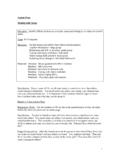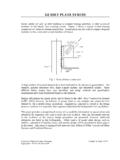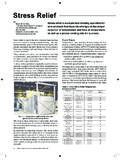Transcription of X-ray Diffraction Residual Stress Measurement AN …
1 A world of solutions AN INTRODUCTION X-ray Diffraction Residual Stress Measurement AN INTRODUCTION What is Residual Stress ?Definition Residual Stress is defined as the Stress resident inside a component or structure after all applied forces have been removed . Compressive Residual Stress acts by pushing the material together, while tensile Residual Stress pulls the material apart. Mathematically, compressive Stress is negative and tensile Stress is positive. Stresses can also be characterized as normal stresses that act perpendicular to the face of a material and shear stresses that act parallel to the face of a material. There are a total of 6 independent stresses at any point inside a material represented by ij where i is the direction that the Stress is acting and j is the face the Stress is acting of Stress SI unit for Stress is the Mega Pascal (MPa).
2 US Customary unit for Stress is kilo pound-force per square inch (ksi). MPa = 1 ksiWhat Causes Residual Stress ? Residual stresses are generated, upon equilibrium of material, after plastic deformation that is caused by applied mechanical loads, thermal loads or phase changes. Mechanical and thermal processes applied to a component during service may also alter its Residual Stress is The Total Stress in a Component?The total Stress experienced by the material at a given location within a component is equal to the Residual Stress plus the applied Stress . TOTAL Stress = Residual Stress + APPLIED STRESSIf a material with a Residual Stress of a -400 MPa is subjected to an applied load of +500 MPa. The total Stress experienced by the material is the summation of the two stresses, or +100 MPa. Therefore, knowledge of the Residual Stress state is important to determine the actual loads experienced by a component.
3 In general, compressive Residual Stress in the surface of a component is beneficial. It tends to increase fatigue strength and fatigue life, slow crack propagation, and increase resistance to environmentally assisted cracking such as Stress corrosion cracking and hydrogen induced cracking. Tensile Residual Stress in the surface of the component is generally undesirable as it decreases fatigue strength and fatigue life, increases crack propagation and lowers resistance to environmentally assisted cracking. Types of Residual StressResidual stresses can be characterized by the scale at which they exist within a material. Stresses that occur over long distances within a material are referred to as macro-stresses. Stresses that exist only locally (either between grains or inside a grain) are called micro-stresses. The total Residual Stress at a given location inside a material is the sum of all 3 types of stresses.
4 Type I Stresses: Macro-stresses occurring over distances that involve many grains within a II Stresses: Micro-stresses caused by differences in the microstructure of a material and occur over distances comparable to the size of the grain in the material. Can occur in single-phase materials due to the anisotropic behaviour of individual grains, or can occur in multi-phase material due to the presence of different III Stresses: Exist inside a grain as a result of crystal imperfections within the grain. Tensile Residual Stress opens crack and increases crack propagation Compressive Residual Stress closes crack and slows crack propagation Stress components inside a materialX-ray Diffraction Residual Stress Measurement Importance of Residual StressResidual Stress affects: Low cycle and high cycle fatigue performance Distortion Peen forming (controlled distortion) Fretting Stress corrosion cracking (SCC) and hydrogen initiated cracking (HIC) Crack initiation and propagation.
5 (Damage tolerance) Residual Stress distribution is rarely as assumed in FE models and or fracture mechanics; real data is necessary to improve the accuracy and effectiveness of the modeling. The Benefits of Measuring and Monitoring Residual Stresses Optimize process parameters, such as measuring the effectiveness of peening on a part at critical locations. Provide a quantitative metric to enable specifications and Go/No-Go decisions. Improve product quality, substantiate supplier quality, engineering source approval (ESA) Improve safety and reduce catastrophic failures. Extend component or structure life by ensuring sufficient compressive Residual Stress is present. Validate repair area has been restored to original specifications. More accurate replacement part requirements by tracking Residual Stress degradation; thus, enabling retirement for quantitative cause.
6 Residual Stress information can improve the probability of detection of other nondestructive Stress ManagementThere are many ways to introduce and manage Residual stresses, among them: cold working techniques, such as shot peening, laser shock peening, ultrasonic peening, planishing, hammering, burnishing, low plasticity burnishing, rolling, coining and split sleeve expanding, can generate compressive Residual stresses. Hot working techniques, such as heat treatment, controlled cooling and localized heating are often used to minimize or reduce the magnitude of Residual Stress in components. Coupons or Almen strips are often used to control the process; unfortunately, they do not provide information about the resultant Residual Stress in the actual component. Peening the Almen strip for example gives details about the peening process, but not about resultant Residual Stress on the part.
7 Additionally, the Almen strip does not account for upstream processing, complex geometry or phase Stress Measurement MethodsX-ray Diffraction can be used to measure Residual Stress using the distance between crystallographic planes, , d-spacing, as a strain gage. When the material is in tension, the d-spacing increases and, when under compression the d-spacing decreases. Stresses can be determined from the measured d-spacings. X-rays diffract from crystalline materials at known angles 2 according to Bragg's Law: n = 2dsin where: n = order of Diffraction = wavelength of the X-ray beam d = distance between lattice planes inside the material = angle of the diffracted beam incident X-ray beam Diffraction cone Polycrystalline Sample Diffraction peaks on detectors d = 0 > 0d + dChanges in Stress cause changes in atomic lattice spacing d and an angular shift of the Diffraction peak.
8 X-ray Diffraction Residual Stress Measurement X-ray tube LXRD Laboratory Residual Stress Measurement System Copyright 2011 - Rev. 11001 X-ray Diffraction Residual Stress Measurement Why X-ray Diffraction is the Preferred Method to Characterize Residual Stress A number of different methods, are available to measure Residual Stress ; however, only a few are actually quantitative. Only X-ray Diffraction has the appropriate spatial and volumetric resolution to fully and adequately characterize the Residual Stress distributions often found in the areas of critical importance. Works on all crystalline materials, such as metals and ceramics High spatial resolution Capable of measuring both surface and sub-surface stresses Nondestructive Quantitative results. Easily validated Low cost per Measurement Can measure dislocation density Capable of measuring Stress in individual phases PortableSurface and Subsurface Residual Stress1.
9 Fatigue cracks normally initiate at the surface of a component, therefore, surface Residual stresses are important in determining the potential for crack initiation and initial propagation. Subsurface crack initiation typically only occurs if a flaw or inclusion is present subsurface. 2. Surface stresses can also strongly influence subsurface crack Surface and Subsurface Stress gradients are required to fully characterize the effects of shot peening, machining or other surface modification In specific cases where machining and other surface modifications are adequately controlled, surface Residual Stress may be used as an indicator of process Stress and Damage Tolerance In fracture mechanics design and lifing paradigms, the assumption of cracks already existing can lead to overly heavy designs (as opposed to LCF based approaches) as well as an undue emphasis on Stress at depth without consideration of surface and near surface Stress distributions.
10 Practical experience and accumulated data have shown surface, near surface and sub-surface stresses are very important to the growth of fatigue cracks and all need to be considered with the assumption of existing cracks. Standards and Guidelines SAE J784a RS Measurement ASTM E915 RS Measurement ASTM E1426 4 pt bend XEC ASM Handbook General guidelinesResidual Stress vs. Depth -1200 -1000 -800 -600 -400 -200 0 200 Depth (mm) Residual Stress (MPa) low intensity peen high intensity peen Measuring Residual Stress on an Airframe with an iXRD Portable SystemResidual Stress vs. Depth for Different Peening Conditions Manufacturing Universal , Michigan48180-4070 Tel 1-313-965-2900 CANADAP roto Manufacturing Solar CrescentOldcastle, OntarioN0R 1L0 Tel 1-519-737-6330 JAPANP roto Manufacturing SakaeFunabashi, Chiba273-0018 Tel +81 (0) 47-402-2703 ISO/IEC 17025:2005









